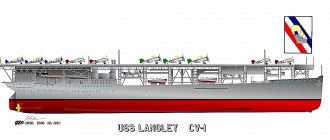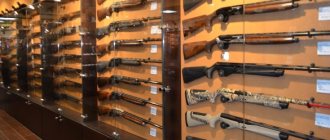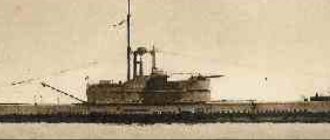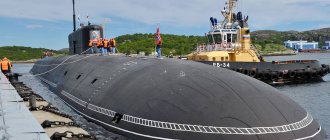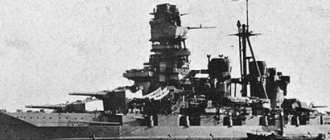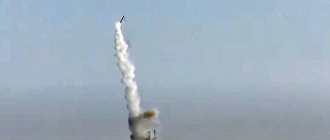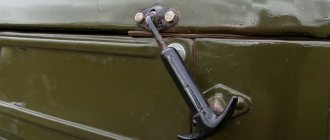US aircraft carriers - equipping the American fleet in 2022
As a preface
Currently, there are only ten countries represented on the world stage that have aircraft carriers in service. The undisputed leader of this ten in terms of the number of aircraft carriers is the United States. The US Navy has 11 aircraft carriers. The second position after America is shared by Italy and Spain, which each have two ships of this type. Then come China, Russia, India, Brazil, France, Thailand and England, which each have one aircraft carrier in service.
A little history
The first US aircraft carrier appeared in 1910 - it was converted from a ship that was intended to transport coal. The following aircraft carriers (Lexington and Saratoga) were the result of the reconstruction of battleships that had not yet been commissioned.
During the Second World War, 24 ships were built that belonged to the class of aircraft carriers. At the end of the war, in the United States, after conducting scientific research and testing, it was decided to create a new generation aircraft carrier that has no analogues in the world. It was a supercarrier named Enterprise. It was commissioned in 1961 and saw service in the Cuban Missile Crisis and the Vietnam War. In 1969, a tragedy occurred - an explosion on an aircraft carrier of one of the missiles, as a result of which 27 people were injured, and the damage caused was estimated at $126 million.
In the current conditions, the presence of aircraft carriers in the country is the personification of power and might. American admirals call such ships the “backbone” of their fleet. This corresponds to reality, since taking into account the capabilities of nuclear aircraft carriers, it must be admitted that they can remain autonomous for several months in water (sea or ocean), at a distance from land bases, in addition, they are capable of developing enormous speed, which allows you to quickly move to any corner of the globe, participate in military operations with the enemy, and be geographically located at a great distance from him with minimal threat to your own safety.
URO CRUISERS
Nuclear cruiser California displacement 10,100 tons, dimensions 181.7 x 18.6 m, draft 6.3 m, engine power. 60,000 hp, speed 30 knots, crew 533, armament: 2 Harpoon anti-ship missile launchers, 2x2 Standard anti-aircraft missile launchers, 1x8 ASROK anti-aircraft missile systems, 4x1 TA-324, 2x1 MK-45, 2x2 Phalanx MK, 1 SH-2; years of construction 1974-75, only 2 pieces, decommissioned in 1999.
Nuclear cruiser Virginia displacement 11000 tons, dimensions 178.3 x 19.2 m, draft 6.4 m, engine power. 60,000 hp, speed 30 knots, crew 533, armament: 8 Harpoon anti-ship missile launchers, 8 Tomohawk missile launchers, 2x2 Standard anti-aircraft missile launchers, 1x8 Asrok anti-aircraft missile systems, 4x1 TA-324, 2x1 MK-45, 2x2 Phalanx MK, 2 MK -38, 1 SH-2; years of construction 1976-80, only 4 pieces, decommissioned in the mid-90s.
Nuclear cruiser Trakstan displacement 8900 (8100) tons, dimensions 164.6 x 17.6 m, draft 6 m, engine power. 60,000 hp, speed 30 knots, crew 490, Armament: 2x4 Harpoon anti-ship missile launchers, 1x2 Terrier anti-aircraft missile launchers, 1x8 Asrok anti-aircraft missile systems, 2x3 TA-324, 1x1 MK-42, 2x6 Phalanx MK, 1 SH-2, year of construction 1967, decommissioned 1995.
Nuclear cruiser Long Beach displacement 16600 (15100) tons, dimensions 219.8 x 21.6 m, draft 9.3 m, engine power. 80,000 hp, speed 30 knots, crew 1107, armament: 2x4 Tomahawk missile launchers, 2x4 Harpoon anti-ship missile launchers, 2x2 Terrier air defense missile launchers, 1x2 Tallos air defense missile launchers, 1x8 Asrok anti-aircraft missile systems, 2x3 TA-324, 2x1 MK-38, 2x6 MK Phalanx, 1 SH-2; built 1961, decommissioned 1995.
Cruiser Ticonderoga displacement 9800 tons, dimensions 172.8 x 16.7 m, draft 9.7 m, engine power. 80,000 hp, speed 32 knots, crew 387, armament: Tomahawk UVP 2x61 cells, 2x4 Harpoon anti-ship missile launchers, 2x2 Standard air defense missile launchers, 1x8 Asrok anti-aircraft missile systems, 2x3 TA-324, 2x1 MK-45, 2x1 ZAU Bushmaster, 2x6 MK Phalanx, 2 SH-60; years of construction 1983-94, in 2000 there were 27 pieces.
Cruiser Belknap displacement 7900 (5400) tons, dimensions 166.8 x 16.7 m, draft 5.5 m, engine power. 85 hp, speed 32 knots, crew 388, armament: 2x4 Harpoon anti-ship missile launchers, 1x2 Terrier anti-aircraft missile launchers, 1x8 Asrok anti-aircraft missile systems, 2x3 TA-533, 1x1 MK-42, 2x6 Phalanx MK, 1 SH-2; years of construction 1964-67, only 10 pieces, all written off in the first half of the 90s.
Cruiser Lehi displacement 7600 (5100) tons, dimensions 162.5 x 16.3 m, draft 5.8 m, engine power. 85 hp, speed 32 knots, crew 377, armament: 4x3 Harpoon anti-ship missile launchers, 2x2 Terrier anti-aircraft missile launchers, 1x8 Asrok anti-aircraft missile systems, 2x3 TA-533, 2x2 76 mm, built 1962-64, 9 in total, all decommissioned in the early 90s.
Review
Team Core
Aircraft carriers are the backbone of a strike group, although such ships are not equipped with their own strong defensive weapons and are not equipped to carry out independent combat operations. An aircraft carrier moves through the water under the cover of other ships. A special feature of the strike group is its ability to cover about 1,500 kilometers in a day without being detected by a potential enemy.
Combat missions
The main purpose of the strike group is:
- carrying out strikes against objects located not only on water, but also on land;
— providing cover for landing forces and ground troops performing combat missions in the coastal zone;
— exercising air control in the area of the planned combat operation;
— performing air defense functions in relation to ships or convoys moving at sea;
- blockade of the enemy's coastal zone;
— conducting aviation reconnaissance operations.
In reality, in peacetime, American air strike groups demonstrate to the world their own strength in key, from a political point of view, moments.
Titans USA
So, in the United States there are eleven aircraft carriers:
- Nimitz - was commissioned into the US Navy in 1975, took part in the war with Iraq.
- Dwight Eisenhower - commissioned in 1977, used in Operation Desert Storm by the US Army. For the first time, an aircraft carrier took part in hostilities only in 1991 (in the Persian Gulf zone).
- Carl Vinson - joined the US Navy in 1982. It is known for the fact that during its existence it was visited by two US presidents (Barack Obama and Bill Clinton), and also for the fact that it carried the body of Osama bin Laden (after his liquidation in 2011), after which it was lowered into Arabian Sea.
- Theodore Roosevelt - became part of the US Navy in 1986, actively used in Operation Desert Storm. Between 2009 and 2013, the ship underwent a $2.6 billion renovation, which extended its service in the US Navy for another 23 years.
- Abraham Lincoln - commissioned in 1989, famous for the fact that female military personnel began to serve on board for the first time.
The ship has a red room where pilots are on round-the-clock combat duty, ready to carry out a combat mission at any time.
- George Washington - has been in operation since 1992, serving mainly in the regions of the South China and East China Seas.
- John C. Stennis - has been in service since 1995. In 2016, he carried out combat missions during international naval exercises, in which troops from 26 states were involved.
- Harry Truman - in service since July 1998. In June 2016, while in the Mediterranean Sea, he provided a large number of sorties during the operation in the fight against ISIS, and also took part, together with the French Navy, in the operation in Syria.
- Ronald Reagan - in service since 2003, its peculiarity is the ability to take on board heavy aircraft, thanks to the modernized braking system. The ship can carry about ninety aircraft and helicopters.
- George Bush - in the US Navy since 2009. This is one of the largest ships in the world, stationed in the Mediterranean Sea and involved in military operations in the fight against terrorists. It is known that this ship is also called a “dirty” aircraft carrier due to a poorly adjusted vacuum flushing system for toilets, and there are 423 of them on board!
- Gerald R. Ford - joined the US Navy in 2022 and became the eleventh in a row. The construction of the aircraft carrier cost the US Treasury $13 billion. However, this cost is fully justified by its technical capabilities. Enemy radars practically do not detect the location of the Gerald Ford. The aircraft carrier is equipped with 25 modern decks and an improved system for interaction (both reception and launch) of aircraft. The commissioning of the new aircraft carrier was postponed several times for technical reasons. It must be said that even after the official commissioning, the aircraft carrier was not fully tested.
According to the plan, by 2023 the American government expects to commission two more aircraft carriers corresponding to the Ford class.
LANDING SHIPS
Landing dock ships Austin displacement 16900 (9200) tons, dimensions 173.4 x 32 m, draft 6.7 m, engine power. 24,000 hp, speed 21 knots, crew 396, landing force 900, armament: 6-76 mm, 2 MK-38, 2 MK Phalanx, 6 SN-46, built 1965-70, 12 in 2000.
Landing ships-docks Whitby Island displacement 16100 tons, dimensions 185.6 x 25.6 m, draft 6.4 m, engine power. 3300 hp, speed 20 knots, crew 391, landing party 500, armament: 2 MK-38, 2 MK Phalanx; years of construction 1985-92, in 2000 8 pieces.
Landing ships dock Anchorage displacement 14000 tons, dimensions 168.6 x 25.9 m, draft 6.1 m, engine power. 24,000 hp, speed 22 knots, crew 340, armament: 2 MK-38, 2 MK Phalanx, 5 in total, 3 in 2000.
Landing ships-docks Harpers Ferry displacement 16,700 tons, dimensions 185.6 x 25.6 m, draft 6.4 m, engine power. 33,000 hp, speed 20 knots, crew 391, landing force 500, armament: RAM air defense systems, 2 MK-38, 2 MK Phalanx, built 1995-98, 4 in 2000.
Universal landing ship Wasp displacement 40500 (28200) tons, dimensions 257.3 x 42.7 m, draft 8.1 m, engine power. 70,000 hp, speed 24 knots, crew 1147, landing force 1893, armament: 6 AV-8B, 32 CH-46, 2x8 Sea Sparrow air defense systems, 2 MK-31 air defense systems, 3 MK-38, 2x6 MK Phalanx; years of construction since 1989, in 2000 there were 6 pieces.
Universal landing ship Tarawa , displacement 40,000 (33,500) tons, dimensions 254.2 x 40.2 m, draft 9.7 m, engine power. 70,000 hp, speed 24 knots, crew 1067, landing party 1903, armament: 16 CH-46, 6 CH-53, 4 UH-1N, 2 MK-31 air defense systems, 2x6 MK Phalanx, built 1976-85, on 2000 5 pieces.
Comparison of US and Russian aircraft carriers
America has 11 aircraft carriers, therefore, in comparison with the Russian Admiral Kuznetsov, you should choose a model of similar type and characteristics. The first Nimitz is such an aircraft carrier. When discussing why America needs so many aircraft carriers that have already been built, and taking into account the fact that the United States is creating new models, while Russia has only one, we must understand the purpose of this type of weapon. And it is necessary when pursuing a policy of domination, which, in fact, is characteristic of the United States. Russia, on the other hand, is focused on a defensive policy; therefore, it is inappropriate to invest money in this area.
An interesting fact is that the Soviet Union had many aircraft carriers, but after its collapse, they were sold. For example, the famous Soviet aircraft carrier “Varyag” was acquired by China, and currently it bears the name “Liaoning”.
NUCLEAR SUBMARINES
Ohio SSBN displacement 18,700 (16,700) tons, dimensions 170.7 x 12.8 m, draft 11.1 m, engine power. 60,000 hp, speed 25 (17) knots, diving depth 365-550 m, crew 155, armament: 24 Trident ballistic missiles, 4 TA-533; years of construction 1981-97, in 2000 there were 18 pieces.
SSBN Benjamin Franklin displacement 8200 (7300) tons, dimensions 129.5 x 10.1 m, draft 9.6 m, engine power. 15,000 hp, speed 25 (20) knots, diving depth 300 m, crew 144, armament: 16 Poseidon S-3 ballistic missiles (Trident 1-S4), 4 TA-533; years of construction 1965-67, only 12 pieces, all written off in the mid-90s.
SSBN James Madison displacement 8200 (7200) tons, dimensions 129.5 x 10.1 m, draft 9.6 m, engine power. 15,000 hp, speed 25 (16) knots, diving depth 300 m, crew 120, armament: 16 Poseidon S-3 ballistic missiles (Trident 1-S4), 4 TA-533; built in 1964, only 10 pieces, all written off in the early 90s.
Nuclear submarine Los Angeles displacement 7100 (6300) tons, dimensions 109.7 x 10.1 m, draft 9.4 m, engine power. 33,000 hp, speed 30 (17) knots, diving depth 250-450 m, crew 141, armament: 12 Harpoon and Tomohawk anti-ship missile launchers, 4 TA-533; years of construction 1974-95, only 62 pieces, 52 in 2000, the rest were written off in the second half of the 90s.
Nuclear submarine Seawulf displacement 9100 (7400) tons, dimensions 107.6 x 12.2, draft 11 m, engine power. 45,000 hp, speed 35 (18) knots, diving depth 480-600 m, crew 126, armament: 8 TA-660 (KR Harpoon and Tomohawk), built 1995-97, 2 in 2000.
Nuclear submarine Sturgeon displacement 5000 (4400) tons, dimensions 92 x 9.7 m, draft 8.7 m, engine power. 30,000 hp, speed 25 (15) knots, diving depth 400-600 m, crew 100, armament: 4 TA-533, built 1970-75, 20 in total, decommissioned in the second half of the 90s.
Nuclear submarine Thresher displacement 4300 (3700) tons, dimensions 84.9 x 9.6 m, engine power. 15,000 hp, speed 30 (20) knots, diving depth 400 m, crew 112, armament: 4 TA-533, built 1961-67, 8 units, all decommissioned before 1993.
Organizational structure
The US Navy has had a fairly conservative and virtually unchanged structure for almost two centuries. Current changes have affected mainly the internal structure of individual commands (middle and senior levels) and main governing bodies. The naval forces include the fleet and infantry, which in turn consist of reserve formations and regular forces. In this case, infantry can formally be equated to a separate branch of the armed forces. There is also a maritime security division under the Department of Homeland Security. But this is only in peacetime. In conditions of emergency or war, it becomes subordinate to the naval forces.
The US Navy, whose composition is constantly being replenished, by mid-2008 included 332 thousand people. Of these, 51 thousand are officers. The number of Marines is 175 thousand people, of which 40 thousand are in reserve.
Naval Headquarters
It is the highest governing body of the country's Navy. It is headed by the chief military commander (essentially the commander) of the naval forces. The Secretary of the Navy gave him overall command of the fleet. He is responsible for the utilization of all government resources and the operational response of the active shore commands of the US Navy base. He also acts as an adviser to the Secretary of the Navy and the President on matters related to the conduct of military operations and is responsible to them for all decisions made. Subordinate to the Commander of the Navy are the first deputy, the administrative chief of staff and four deputies who head the main directorates (network systems and communications; development and planning of strategic concepts; education, personnel and training of personnel who will subsequently be selected for the US Navy uniform; integration of resources and capabilities ).
Department of the Navy
This is the highest administrative body for the management of the Marine Corps and Navy forces. In accordance with the tenth article of the constitution, the Secretary of the Navy controls all daily activities of the ministry, including those related to demobilization, mobilization and organizational activities, the formation of personnel, equipment, equipment, supplies, training of units and formations of the US Navy, a photo of which is attached to this article. The Minister is also responsible for reviewing programs for the production (or construction), repair and modernization of ships, equipment and military equipment, as well as coastal structures and facilities. In addition, he formulates strategic concepts and programs related to the preservation of national security, in accordance with the orders of the Minister of Defense and the President of the country.
Fleet operational headquarters
They are combined with the headquarters of other operational fleets (4th, 5th and 6th) and have a clear organizational structure, verified by many years of military experience. Such a headquarters, headed by a deputy commander, includes staff departments (intelligence, operations, personnel, operational planning, logistics, etc.) and departments (chaplain, medical, security, etc.).
